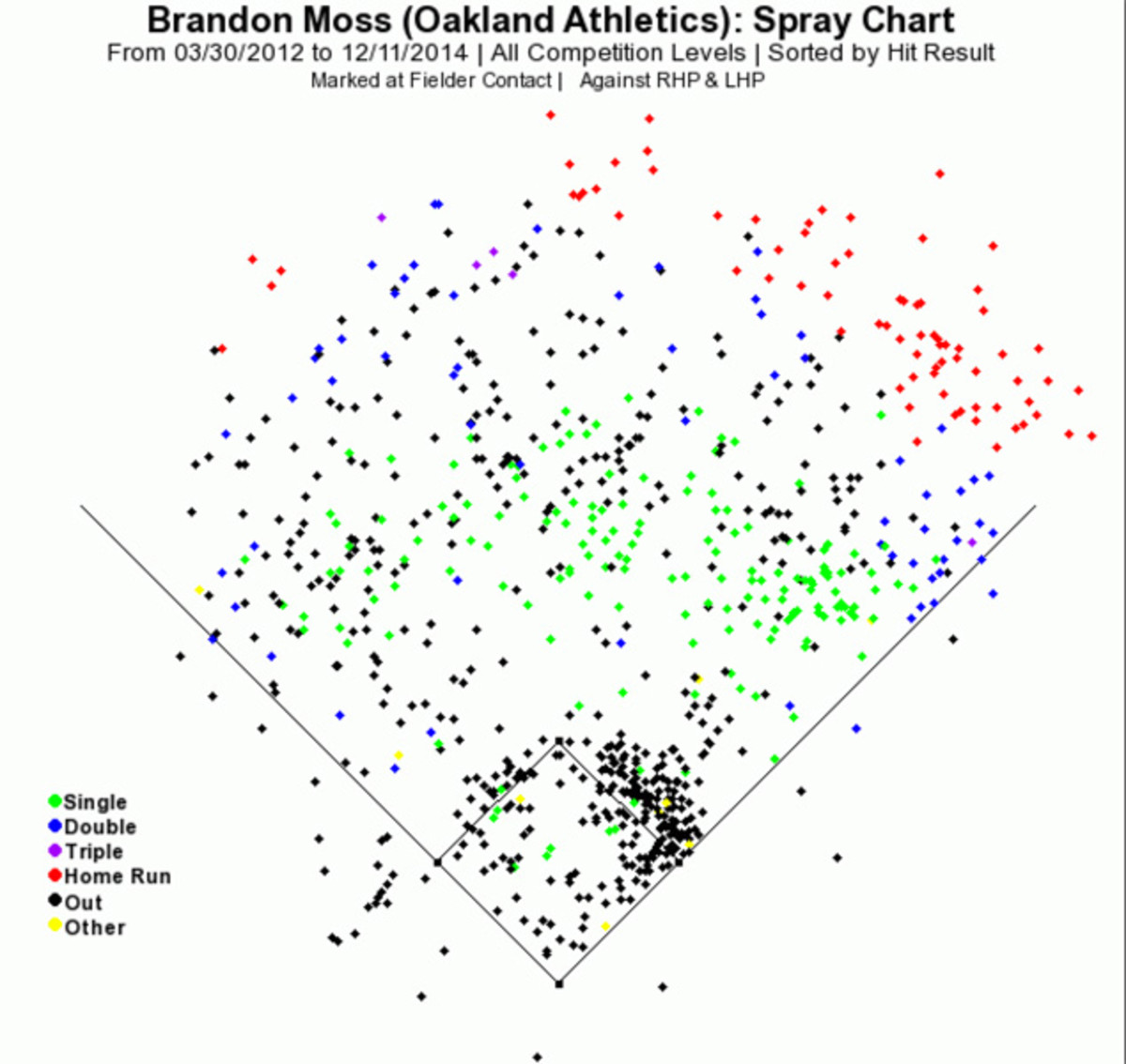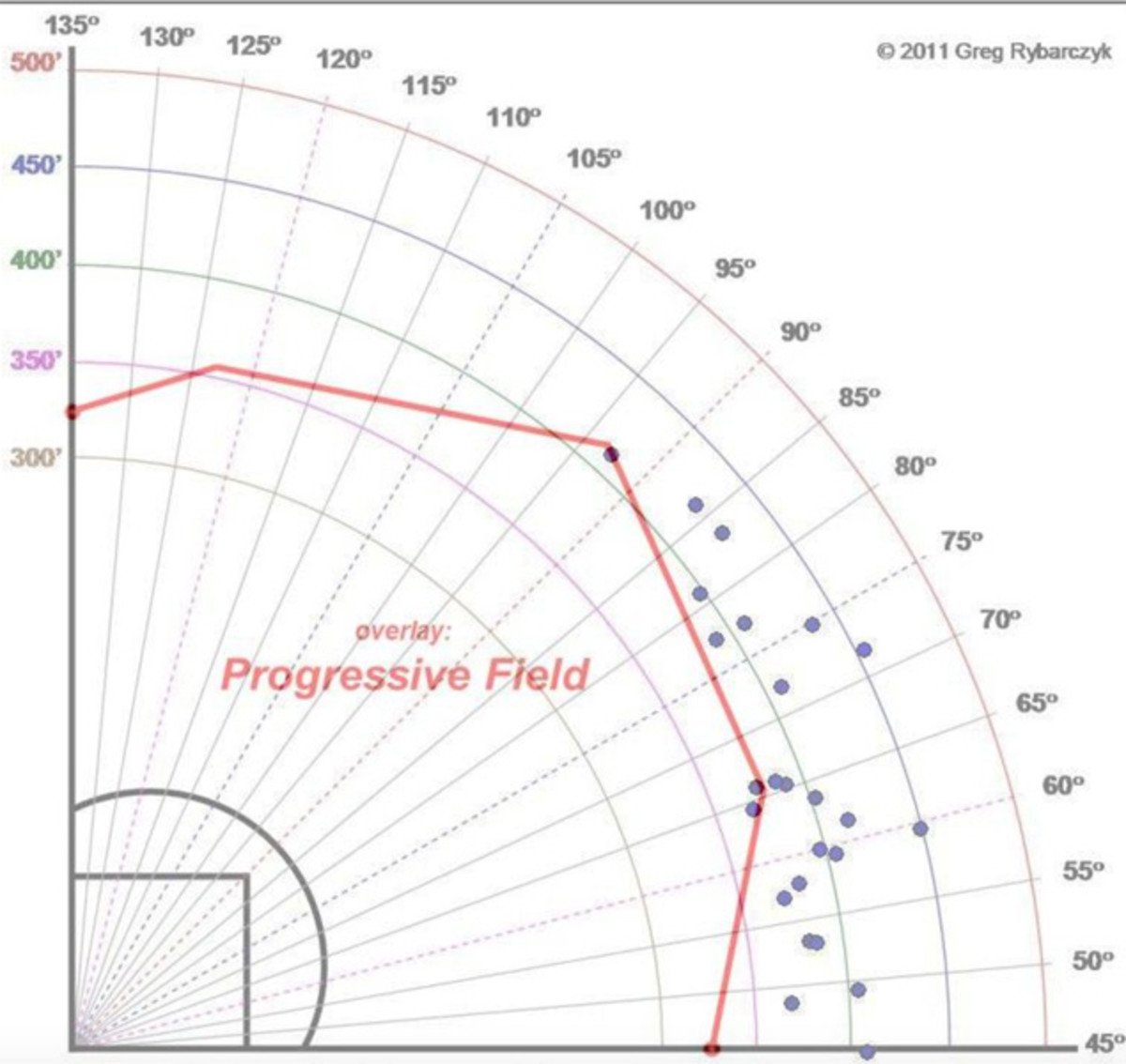Winter Meetings Recap: Fantasy value of Moss trade, other moves

One of the most action-packed Winter Meetings in history is now behind us. We’ve already wrapped up the fantasy impact of the major moves. Now let’s take a lightning-round look at the minor ones that would have been front-page news in many of the more boring Winter Meetings of yore.
Who says power comes at a premium?
We’ve heard all about how power is hard to find these days, but then the Indians went out and found some in the form of Brandon Moss and they didn’t have to give up anything significant in player cost.
Moss, 31, has quietly been one of the better hitters in the league over the last three seasons. Of course, his unsustainable half-season in 2012 when he hit .291/.358/.596 with 21 homers and 160 wRC+ in 296 plate appearances drove that, but the fact remains that he has 135 wRC+ in the last three years. Even last year, his worst during the stretch, he had a .772 OPS, 121 wRC+ and 25 homers in 580 plate appearances.
New front office puts its stamp on Dodgers with flurry of acquisitions
There’s plenty of reason to believe Moss can have the best season of his career playing have his games at Progressive Field. O.co Coliseum suppresses left-handed power to a significant degree. Progressive increases overall homers by 8.3 percent, and left-handed power specifically by 9 percent. On the flip side, O.co holds it down by 12 percent.
Here’s Moss’ spray chart over the last three years, courtesy of Brooks Baseball, with home runs in red.

And here’s his home-run chart last year, with an overlay of Progressive Field, from ESPN’s Hit Tracker.

Nearly all of Moss’ homers are making it out of his new home park with ease. Moss struggled mightily at O.co last year, hitting .197/.299/404. That slash jumped all the way to .265/.364/.467 when the A’s took their show on the road. Assuming Moss is the same player with the same batted-ball rates, a relatively safe assumption given that they have remained generally flat over the last three years, Moss could easily push north of 30 home runs playing 81 games in Cleveland this year.
Dee Gordon gets the best gigs
Few of us get to work in Los Angeles for a few years, then leave for a new job in Miami, but that’s exactly what Gordon did when the Dodgers sent him, along with Dan Haren, to South Beach as part of the three-team trade that landed them Howie Kendrick. Gordon joins a Marlins’ team that hung around the wild-card race despite losing Jose Fernandez to a significant elbow injury that required Tommy John surgery. He also enjoyed a breakout fantasy season thanks to his speed, but there are some serious red flags with the second baseman.
Gordon hit .289 and stole 64 bases last year, making the All-Star team for the first time in his career. He made it to the Midsummer Classic purely because his few good months last season came during the first half. Gordon hit .344/.375/.478 in April and .303/.358/.475 in June. After the All-Star break, he hit .284/.300/.348 for the rest of the season. Gordon had a .346 BABIP, and while he’s always going to be able to post a higher-than-expected BABIP thanks to his speed (he had 31 infield hits last year), the 4.8-percent walk rate just isn’t going to get it done. If Gordon’s batting average comes crashing down next season, his stolen bases will come with it. He’s a very dangerous one-category player.
Andrew Heaney lands out west
Heaney was briefly a member of the Dodgers after being dealt for Gordon, but he was quickly flipped to the Angels for Kendrick. Heaney is one of the premier pitching prospects in the majors, despite struggling in his brief stint with the Marlins last year. The 23-year-old lefty posted a 2.34 ERA, 1.08 WHIP and 52 strikeouts in 53 2/3 innings at Double-A Jacksonville last year. He moved up to Triple-A New Orleans, where he compiled a 3.87 ERA, 1.17 WHIP and 91 strikeouts in 83 2/3 innings. In just less than 30 major league frames, however, he was touched up for a 5.83 ERA, 5.45 FIP and 1.33 WHIP with 20 strikeouts against seven walks.
Winter meetings roundup: Tigers get Cespedes, Marlins snag Latos
Heaney profiles as a potential top-of-the-rotation starter, and nothing that happened last year changes that. He may never be a true ace, but he can easily be a real-life 2/3, and there’s plenty of value in a guy like that in fantasy leagues, especially one who can miss bats the way Heaney does. There are spots to be won in the Angels’ rotation. Garrett Richards is still recovering from a gruesome knee injury, and is already expected to miss all of April. Even when he returns, the Angels have an open slot behind him, Jered Weaver, Matt Shoemaker and C.J. Wilson. Hector Santiago and Nick Tropeano will be in the mix, but Heaney is clearly the most talented of the bunch. Assuming he breaks spring training in the rotation, he’ll be a strong pitcher to target toward the end of your draft.
The Cubs get their catcher in Miguel Montero
Before making the biggest signing at the Winter Meetings, Theo Epstein and Jed Hoyer filled the Cubs’ hole behind the plate by trading two minor league pitchers for Montero, assuming the rest of his contract, which has $40 million remaining over the next three seasons. The Cubs clearly needed an upgrade at the position from Welington Castillo and they got one, even though Montero has been bringing diminishing returns over the last two years. For Montero, he could not have landed in a better spot for a few reasons.
For Athletics, rebuild necessary after failed playoff run in 2014
While Montero’s power lagged in 2013 and 2014, he can still mash against righties. Even in his down years, he has been league average against right-handed pitching. When he was putting up big offensive numbers, he was doing most of his damage against opposite-siders. All told, he has a career .272/.356/.442 slash against righties. That’s very valuable, especially when you consider that he’ll be making up the left side of a left-right platoon with Castillo. And therein lies the rub for his fantasy value, and why this is a great move for him in real life, but maybe not in our peculiar little hobby.
Montero has been beaten up behind the plate, catching at least 130 games in three of the last four seasons. Back problems in 2013 limited him to 112 games and it’s clear he’s better off in the sort of platoon he’ll be in with the Cubs. Of course, that’s not something a fantasy owner wants to hear. It’s certainly possible that the Cubs use Montero for something like 105 games and Castillo for around 60. If you could combine the two, they may be attractive as a back-end option in mixed leagues, but it’s possible neither will get enough playing time to be more than an NL-only option. There’s little more we can do the speculate in December, but the bet for now is that Montero ends up being an endgame catcher who finds himself on the waiver wire in most mixed leagues, unless he rediscovers the consistent power stroke he had 2009 through 2011.
Mat Latos lands in Miami
Prior to 2014, Latos had been a durable No. 2-range starter. In four years split evenly between the Padres and Reds, he had at least 31 starts every season and a FIP that ranged between 3.00 and 3.85. His strikeout rate dipped every season, but he was still up at a 21.2-percent strikeout rate and nearly eight whiffs per nine innings in 2013. That all changed last year, when he dealt with elbow and knee injuries and his average fastball velocity fell to 90.7 mph from 92.6 mph the previous season. Latos was mostly healthy at the end of the year, though the Reds shut him down the first week of September. He’s also just entering his age-27 season, so he is going into his theoretical prime.
Latos certainly should benefit from trading the Great American Ballpark for Marlins Park as his home stadium, but it could just be a marginal upgrade. Latos has a career fly-ball rate of 38.3 percent, but during his first two years in Cincinnati, his fly-ball rate was 36.1 percent and 33.6 percent. If he were an extreme fly-ball pitcher with a high HR/FB rate, getting out of the bandbox that is the Great American Ballpark would be a huge boon to his fantasy value. Since he’s more of a ground-ball guy, he won’t experience as much of a bump as someone who puts a lot of balls in the air.
It’s tempting to say that a player’s value has experienced a significant shock as the result of a trade, but Latos is the same guy in Miami that he would have been in Cincinnati. From a fantasy standpoint, the most important factor is his health. If his lack of strikeouts and dip in velocity were due largely to his inability to stay healthy, Latos can jump back up into the mid-20s among starting pitchers. If that's the sign of a decline in skill set, however, he’s a mid-to-late-30s rank at the position. As you put together your draft board, you have to bake that injury risk into his ranking. There are plenty of starting pitcher options in his neighborhood that you don’t have to reach for his ceiling.
